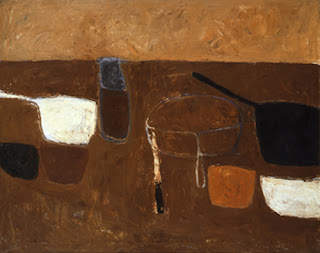Camouflaged Soldiers, 1943, Oil on canvas, 70 x 35 cm
William Scott was born in Greenock in 1913. In 1924, his family moved to his father’s home town of Enniskillen in Northern Ireland where he later enrolled at the Belfast School of Art, moving to London three years later to take up a place at the Royal Academy Schools, initially in the sculpture department, later changing to painting. Girl and a Birdcage, c.1947, Oil on canvas, 78.8 x 86.4 cm
In 1951, he was one of sixty artists invited by the Arts Council to exhibit as part of the celebrations marking the Festival of Britain. Around this time, his work moved closer to non-figuration and his first one-man show at the Hanover Gallery in London, which opened in June 1953, included a number of virtually abstract paintings. That year, he took an extended visit to North America which resulted in friendships with New York based artists including Mark Rothko and William de Kooning. One of the first British artists to be aware of Abstract Expressionism, the work he saw in America made Scott aware of how much his painting was, and would continue to be, tied to a European artistic tradition. Indeed throughout the 1960s his work was exhibited across Europe and, recognising his important place in contemporary art, the Tate Gallery in London held a major retrospective of over 125 paintings in 1972.
Brown Still Life, 1957, Oil on canvas, 102 x 127 cm
Throughout his career, the themes of still-life, landscape and the female nude recur in Scott’s work. Although there are phases where his paintings could be called abstract, more often they explore the space between abstraction and figuration. Scott said, “I am an abstract artist in the sense that I abstract. I cannot be called non-figurative while I am still interested in the modern magic of space, primitive sex forms, the sensual and the erotic, disconcerting contours, the things of life.”
Berlin Blues 1, 1965, Oil on canvas, 160 x 173 cm
‘Whithorn’ was commissioned from William Scott in 1961 by the architect Eugene Rosenberg for the interior of Altnagelvin Hospital, Derry, the first new hospital to be built in Britain following the introduction of the National Health Service. Scott had already been commissioned to paint a 45-foot-long mural for the hospital, entitled Four Seasons (1959). ‘Whithorn’ was translated from drawing to textile by the Edinburgh Weavers, who were known for producing cutting-edge designs by leading artists.
Whithiorn textile, 1961, screen-printed linen, 28.1 x 12.5 cm
The textile design was bought in 2006, for £5,000 from the London art collector Francesca Galloway by Fermanagh District Council with a contribution from The Art Fund with the assistance of the Esmée Fairbairn Foundation. While the design could be read as hinting at the colours of stone and the early circular headed crosses of Whithorn, there is unfortunately no firm evidence of Scott visiting the town or of who gave the pattern its name. It is also not known how many metres of the fabric were printed for the hospital but the repeated motif is quite small, about 6 x6 cm, so the overall effect of the pattern would have been of verticals, dashes of black and white contrasting with the bands of brown.
However, in fact the original design was to scale and a recently discovered photograph of the work of the Edinburgh Weavers at Scottish Council of Industrial Design exhibition in 1961 shows the textile hanging to in the far left of the photograph. It is clear from this that the original, two circle repeat covered the width of the fabric.
(With thanks to Mr Hugh Mann for this image.)








No comments:
Post a Comment